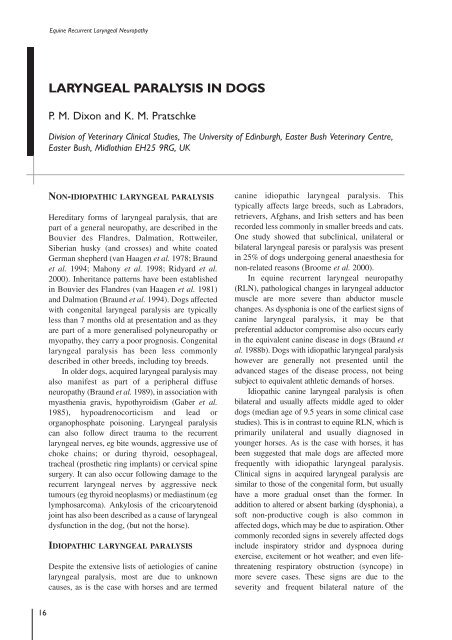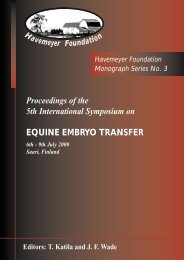Proceedings of a Workshop on - The Havemeyer Foundation
Proceedings of a Workshop on - The Havemeyer Foundation
Proceedings of a Workshop on - The Havemeyer Foundation
You also want an ePaper? Increase the reach of your titles
YUMPU automatically turns print PDFs into web optimized ePapers that Google loves.
Equine Recurrent Laryngeal Neuropathy<br />
LARYNGEAL PARALYSIS IN DOGS<br />
P. M. Dix<strong>on</strong> and K. M. Pratschke<br />
Divisi<strong>on</strong> <str<strong>on</strong>g>of</str<strong>on</strong>g> Veterinary Clinical Studies, <strong>The</strong> University <str<strong>on</strong>g>of</str<strong>on</strong>g> Edinburgh, Easter Bush Veterinary Centre,<br />
Easter Bush, Midlothian EH25 9RG, UK<br />
NON-IDIOPATHIC LARYNGEAL PARALYSIS<br />
Hereditary forms <str<strong>on</strong>g>of</str<strong>on</strong>g> laryngeal paralysis, that are<br />
part <str<strong>on</strong>g>of</str<strong>on</strong>g> a general neuropathy, are described in the<br />
Bouvier des Flandres, Dalmati<strong>on</strong>, Rottweiler,<br />
Siberian husky (and crosses) and white coated<br />
German shepherd (van Haagen et al. 1978; Braund<br />
et al. 1994; Mah<strong>on</strong>y et al. 1998; Ridyard et al.<br />
2000). Inheritance patterns have been established<br />
in Bouvier des Flandres (van Haagen et al. 1981)<br />
and Dalmati<strong>on</strong> (Braund et al. 1994). Dogs affected<br />
with c<strong>on</strong>genital laryngeal paralysis are typically<br />
less than 7 m<strong>on</strong>ths old at presentati<strong>on</strong> and as they<br />
are part <str<strong>on</strong>g>of</str<strong>on</strong>g> a more generalised polyneuropathy or<br />
myopathy, they carry a poor prognosis. C<strong>on</strong>genital<br />
laryngeal paralysis has been less comm<strong>on</strong>ly<br />
described in other breeds, including toy breeds.<br />
In older dogs, acquired laryngeal paralysis may<br />
also manifest as part <str<strong>on</strong>g>of</str<strong>on</strong>g> a peripheral diffuse<br />
neuropathy (Braund et al. 1989), in associati<strong>on</strong> with<br />
myasthenia gravis, hypothyroidism (Gaber et al.<br />
1985), hypoadrenocorticism and lead or<br />
organophosphate pois<strong>on</strong>ing. Laryngeal paralysis<br />
can also follow direct trauma to the recurrent<br />
laryngeal nerves, eg bite wounds, aggressive use <str<strong>on</strong>g>of</str<strong>on</strong>g><br />
choke chains; or during thyroid, oesophageal,<br />
tracheal (prosthetic ring implants) or cervical spine<br />
surgery. It can also occur following damage to the<br />
recurrent laryngeal nerves by aggressive neck<br />
tumours (eg thyroid neoplasms) or mediastinum (eg<br />
lymphosarcoma). Ankylosis <str<strong>on</strong>g>of</str<strong>on</strong>g> the cricoarytenoid<br />
joint has also been described as a cause <str<strong>on</strong>g>of</str<strong>on</strong>g> laryngeal<br />
dysfuncti<strong>on</strong> in the dog, (but not the horse).<br />
IDIOPATHIC LARYNGEAL PARALYSIS<br />
Despite the extensive lists <str<strong>on</strong>g>of</str<strong>on</strong>g> aetiologies <str<strong>on</strong>g>of</str<strong>on</strong>g> canine<br />
laryngeal paralysis, most are due to unknown<br />
causes, as is the case with horses and are termed<br />
canine idiopathic laryngeal paralysis. This<br />
typically affects large breeds, such as Labradors,<br />
retrievers, Afghans, and Irish setters and has been<br />
recorded less comm<strong>on</strong>ly in smaller breeds and cats.<br />
One study showed that subclinical, unilateral or<br />
bilateral laryngeal paresis or paralysis was present<br />
in 25% <str<strong>on</strong>g>of</str<strong>on</strong>g> dogs undergoing general anaesthesia for<br />
n<strong>on</strong>-related reas<strong>on</strong>s (Broome et al. 2000).<br />
In equine recurrent laryngeal neuropathy<br />
(RLN), pathological changes in laryngeal adductor<br />
muscle are more severe than abductor muscle<br />
changes. As dysph<strong>on</strong>ia is <strong>on</strong>e <str<strong>on</strong>g>of</str<strong>on</strong>g> the earliest signs <str<strong>on</strong>g>of</str<strong>on</strong>g><br />
canine laryngeal paralysis, it may be that<br />
preferential adductor compromise also occurs early<br />
in the equivalent canine disease in dogs (Braund et<br />
al. 1988b). Dogs with idiopathic laryngeal paralysis<br />
however are generally not presented until the<br />
advanced stages <str<strong>on</strong>g>of</str<strong>on</strong>g> the disease process, not being<br />
subject to equivalent athletic demands <str<strong>on</strong>g>of</str<strong>on</strong>g> horses.<br />
Idiopathic canine laryngeal paralysis is <str<strong>on</strong>g>of</str<strong>on</strong>g>ten<br />
bilateral and usually affects middle aged to older<br />
dogs (median age <str<strong>on</strong>g>of</str<strong>on</strong>g> 9.5 years in some clinical case<br />
studies). This is in c<strong>on</strong>trast to equine RLN, which is<br />
primarily unilateral and usually diagnosed in<br />
younger horses. As is the case with horses, it has<br />
been suggested that male dogs are affected more<br />
frequently with idiopathic laryngeal paralysis.<br />
Clinical signs in acquired laryngeal paralysis are<br />
similar to those <str<strong>on</strong>g>of</str<strong>on</strong>g> the c<strong>on</strong>genital form, but usually<br />
have a more gradual <strong>on</strong>set than the former. In<br />
additi<strong>on</strong> to altered or absent barking (dysph<strong>on</strong>ia), a<br />
s<str<strong>on</strong>g>of</str<strong>on</strong>g>t n<strong>on</strong>-productive cough is also comm<strong>on</strong> in<br />
affected dogs, which may be due to aspirati<strong>on</strong>. Other<br />
comm<strong>on</strong>ly recorded signs in severely affected dogs<br />
include inspiratory stridor and dyspnoea during<br />
exercise, excitement or hot weather; and even lifethreatening<br />
respiratory obstructi<strong>on</strong> (syncope) in<br />
more severe cases. <strong>The</strong>se signs are due to the<br />
severity and frequent bilateral nature <str<strong>on</strong>g>of</str<strong>on</strong>g> the<br />
16








